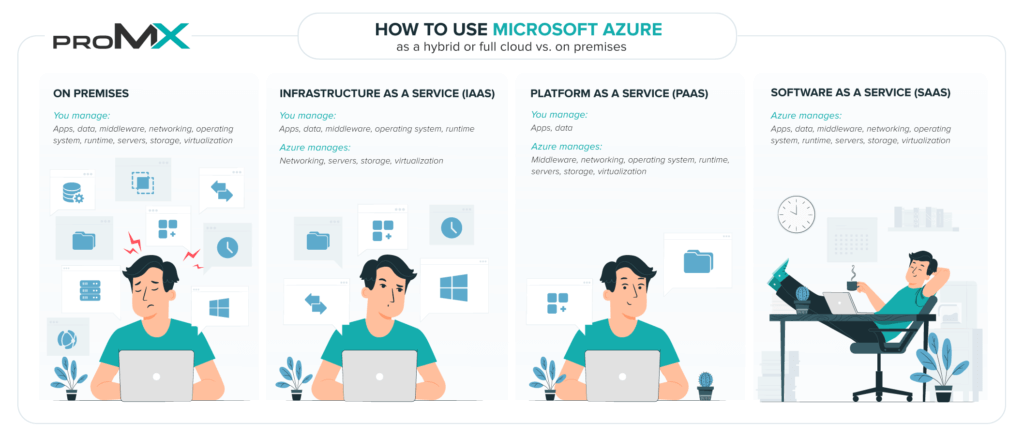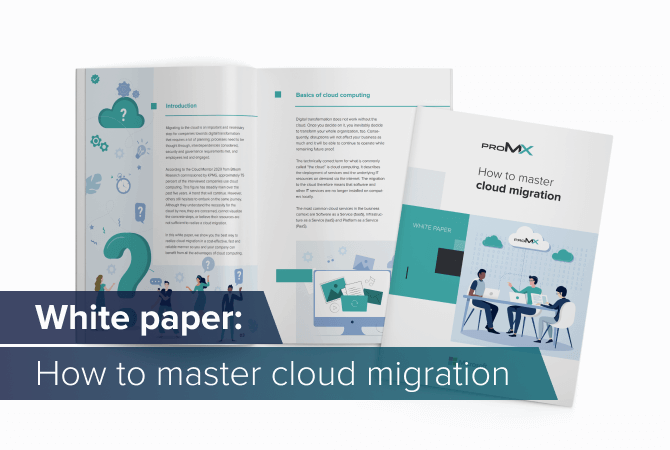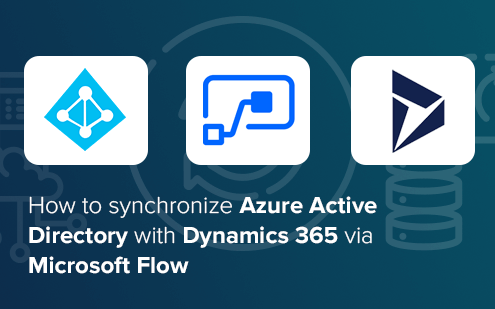
Four reasons why companies should work with Microsoft Azure
Do you find yourself working in a rapidly aging, vulnerable and expensive IT system? Well, then you are as likely to keep up with your competition as winning a 100-meter spring against Usain bolt. The key technologies of the futures – Artificial Intelligence, Machine Learning, Mixed Reality – are all based on the cloud.
Therefore, if you are serious about truly turning into an agile organization equipped for the future, cloud computing is your best chance.
What is Azure?
Azure is Microsoft’s corporate cloud-computing platform with more than 200 different applications and services. Their purpose is to support organizations with the challenges they face.
Azure provides everything as-a-service. That means organizations no longer have to dedicate resources to maintaining their own servers and are instead given the option to rent them from Microsoft. They receive a monthly bill based on their usage and as a result become more flexible.
Virtual machines, DNS servers, Windows server services, data bases, data archives, backups and disaster recovery are among the most popular Azure services.
Azure is a great fit for organization of all sizes and all industries, and makes starting with cloud computing easy. It is a highly flexible platform that offers many different programming languages, tools and frameworks provided by both Microsoft and third parties. And it is compatible with open-source technologies, too.
Amidst Amazon Web Services (AWS) and the Google Cloud Platform, Azure is among the three largest corporate clouds. Popular services like Office, Bing and Xbox are hosted on Azure, which makes the platform stand out.
(click to enlarge)
How to use Microsoft Azure as a hybrid or full cloud, as compared to on premises
Four reasons why using Microsoft Azure is a good idea
When it comes to cloud migration and cloud security in particular, many organizations are still critical. But facts speak for themselves – and for Microsoft Azure.
Our top reasons why you should work with Microsoft Azure:
1. Azure is more secure than on-premises servers
Maintaining your own servers gives you a sense of control. You know where they are located and who works on and with them. However, with a public cloud like Microsoft Azure, it feels like you are less in control: Is your data really save there? And after all, Microsoft is a company based in the US where safety standards are lower. And – are you even allowed to host data in another country?
Microsoft has some reassuring answers to all of these questions:
- EU authorities have given approval to Microsoft’s cloud service Azure and has been certified, by the Cloud Computing Compliance Criteria Catalogue (C5) of the German Federal Office for Information Technology, among others.
- The data of organizations based in Germany is automatically saved in a German data center, which adhere to German laws.
- Azure supports hybrid clouds, too: That way, it is up to organizations to decide where to store their data.
Is the same really true for your own servers? Are they safe from, say, hackers? Few local servers turn out as safe and as reliable as public clouds, which have a significant number of resources dedicated to their maintenance by companies like Microsoft.
With options like cloud-based security services, geographical distribution and data replication organizations are even able to enhance their security when migrating to the cloud. Azure offers protection against data leaks, malware and phishing attacks.
According to Microsoft, more than 3,500 experts are working on Microsoft Azure’s cloud security.
→ The Microsoft Trust Center provides you with more information about security, data protection and compliance.
2. Azure is more cost-efficient than maintaining your own server
Cloud migration does not only reduce an organization’s costs for purchasing and maintaining their own servers, but eliminates them altogether. The same goes for additional costs for security measures. All of that is in the hands of Microsoft now.
With Azure, you only pay for what you actually use. That leaves you with enough flexibility to scale down when you need fewer resources. (In turn, additional resources are available much more quickly as opposed to maintaining your own server.)
Working with Microsoft Azure means your IT experts must no longer spend valuable time maintaining an infrastructure the organization does not benefit from; instead, they are able to contribute to a productive day-to-day business.
If an organization is interested in migrating to Microsoft Azure, Microsoft has some great offers:
- You can try Azure for free for one month.
- It comes with 25 complimentary services.
- If you are in for the long haul, you can purchase many services at a lower price.
- During the first 30 days, Azure offers you 170 € in credits.
- With a free Azure account, you can use popular products for free for 12 months.
Microsoft charges Azure usage by full minutes.
→ The Azure pricing calculator gives you a good idea of what costs to expect.
3. Azure offers near infinite possibilities
Azure will drive innovation in your organization. Cloud-based apps enable employees to become more mobile, flexible and productive in their work; the Internet of Things tracks useful data that helps optimize processes; Artificial Intelligence automizes recurring or tedious tasks; Big Data delivers valuable insights into different parts of your organization. Of course, these improvements will leave an impact on your business results, too.
Azure offers tools for all levels of knowledge and proficiency that employees can adopt, starting from the development of simple apps by using drag-and-drop elements or templates.
If an organization would like to get started with the Internet of Things, for example, all it needs are a sensor and Azure IoT Central.
In just one year, more than 1,000 functionalities were added to Azure.
→ Microsoft provides an innovation guide for Azure.
4. Microsoft users do not have to get used to Microsoft Azure
The main difference between Azure and other public clouds is the simple fact that Microsoft is more than Azure. Yes, Google has a suite of apps, too. But they pale in comparison to what Microsoft has to offer: The company provides organizations with everything they need – an operating system, office software, IoT solutions, you name it. Many of Microsoft’s products connect seamlessly to each other and to Azure. The interface alone is something users of Microsoft 365, Exchange or SharePoint are more than familiar with.
Of course, Azure also works with apps from other developers. It is needless to say though that Microsoft knows its own products better than those of its competitors. Yes, running Dynamics 365 on Amazon Web Services is possible, but it was created for Azure, and therefore it works best there.
It makes implementation much faster, cost-efficient and successful, because there are no adjustments required.
Microsoft users show a flatter learning curve with Azure than with other clouds.
→ How does Azure compare to AWS? Find out here.
Conclusion: There is no digital transformation without the cloud
Modern organizations need to stay agile, flexible, productive and innovative. They need to be everything the cloud promotes.
At first sight, forcing cloud migration may seem unfair. If you take a closer look, however, you will quickly find that a public cloud like Microsoft Azure offers nothing but flexibility.
Companies often have doubts when faced with the decision whether to migrate to the cloud: expensive, risky, daunting to think about. However, cloud migration is an important part of digital transformation – and you won’t have to do it on your own! As a reliable Microsoft partner, we will be at your side to guide you, implement all necessary technologies and answer any questions you may have.











